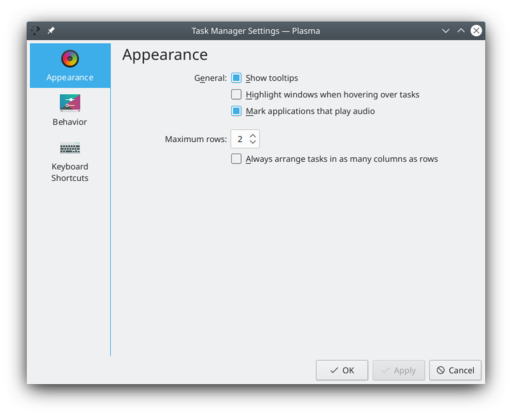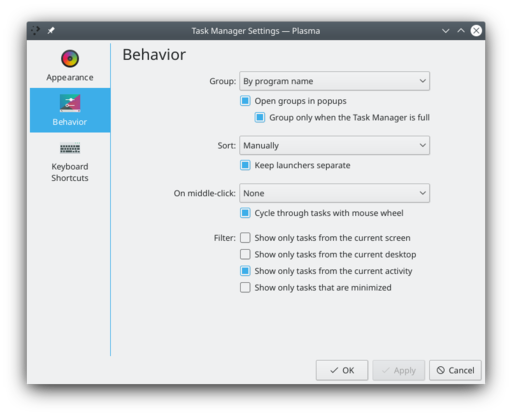Plasma/Tasks/de: Difference between revisions
(Created page with "=== Das Fensterleisten-Miniprogramm ===") |
(Created page with "Die '''Fensterleiste''' ist genaugenommen ein Mini-Programm, das bedeutet das Sie sie überall hin platzieren können. Beispielsweise können Sie die Fensterleiste auch in ein...") |
||
| Line 8: | Line 8: | ||
=== Das Fensterleisten-Miniprogramm === | === Das Fensterleisten-Miniprogramm === | ||
Die '''Fensterleiste''' ist genaugenommen ein Mini-Programm, das bedeutet das Sie sie überall hin platzieren können. Beispielsweise können Sie die Fensterleiste auch in eine zusätzliche Kontrollleiste am oberen Bildschirmrand einfügen oder sie kann auch direkt auf die Arbeitsfläche gelegt werden. Sie können auch mehrere Fensterleisten an verschiedenen Orten haben. | |||
Whenever you start an application you will see a new tab in the '''Task Manager''' showing the icon of the application and the title of the window that was opened. | Whenever you start an application you will see a new tab in the '''Task Manager''' showing the icon of the application and the title of the window that was opened. | ||
Revision as of 21:27, 21 April 2020
Die Plasma Fensterleiste

Die Fensterleiste ermöglicht den einfachen Zugriff auf laufende Programme. Sie befindet sich im mittleren Teil der Kontrollleiste. Falls ein Fenster von einem anderen Fenster verdeckt wird oder wenn es minimiert wurde, können Sie es wieder nach vorne bringen indem Sie auf den entsprechenden Programm-Reiter in der Fensterleiste klicken.
Das Fensterleisten-Miniprogramm
Die Fensterleiste ist genaugenommen ein Mini-Programm, das bedeutet das Sie sie überall hin platzieren können. Beispielsweise können Sie die Fensterleiste auch in eine zusätzliche Kontrollleiste am oberen Bildschirmrand einfügen oder sie kann auch direkt auf die Arbeitsfläche gelegt werden. Sie können auch mehrere Fensterleisten an verschiedenen Orten haben.
Whenever you start an application you will see a new tab in the Task Manager showing the icon of the application and the title of the window that was opened.
If you click on the tab corresponding to the active window then that window will be minimized. If there are still windows that have not been minimized then the frontmost of them will become active. If you click on the tab of a minimized window it will be displayed in front of all other windows, and it will become active. If you click on the tab of a window which is displayed behind other windows it will be brought in front of all other windows, and it will become active.
You can also right-click a tab to bring up the context menu. This gives you a number of options. For example, you can set which virtual screens the windows are displayed on, and you can close the window.

If you have many windows opened the tabs may be grouped. In that case you will see a number with a small arrow above in the right hand side of the tab. Clicking on such a tab will bring up a list of tabs for individual windows that you can use just like ordinary Task Manager tabs. Right-clicking a group gives you the option to close all windows in that group.
You can also activate windows by holding Alt down while pressing Tab one or more times. This way you browse through all windows whether displayed or minimized.
Configuration
To access the Task Manager settings menu, right-click on it and click . If you have troubles to click on it and not in one of its tasks, you can first click the panel toolbox, so wherever you click on the Task Manager will work.


There you can change its behavior. The following settings are particularly useful:
- Grouping and Sorting
- Grouping can be by , manually, or not at all. (You can also choose to only enable grouping if the taskbar is full.) Similarly, Sorting defaults to , but it can also be , , or .
- Show only tasks from the current desktop
- A checkbox on the Filters section.
- Have More than One Row on the Taskbar
- If you use many applications at one time you may find it advantageous to set and then .
- Showing Tooltips
- A simple checkbox in the Appearance section of the page.

